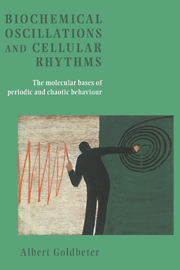Book contents
- Frontmatter
- Contents
- Foreword to the English edition by Michael Berridge
- Foreword to the French edition by Ilya Prigogin
- Preface
- 1 Introduction
- Part I Glycolytic oscillations
- Part II From simple to complex oscillatory behaviour
- Part III Oscillations of cAMP in Dictyostelium cells
- Part IV From cAMP signalling in Dictyostelium to pulsatile hormone secretion
- Part V Calcium oscillations
- Part VI The mitotic oscillator
- Part VII Circadian rhythms
- 11 Towards a model for circadian oscillations in the Drosophila period protein (PER)
- 12 Conclusions and perspectives
- References
- Index
12 - Conclusions and perspectives
Published online by Cambridge University Press: 26 February 2010
- Frontmatter
- Contents
- Foreword to the English edition by Michael Berridge
- Foreword to the French edition by Ilya Prigogin
- Preface
- 1 Introduction
- Part I Glycolytic oscillations
- Part II From simple to complex oscillatory behaviour
- Part III Oscillations of cAMP in Dictyostelium cells
- Part IV From cAMP signalling in Dictyostelium to pulsatile hormone secretion
- Part V Calcium oscillations
- Part VI The mitotic oscillator
- Part VII Circadian rhythms
- 11 Towards a model for circadian oscillations in the Drosophila period protein (PER)
- 12 Conclusions and perspectives
- References
- Index
Summary
From the molecular properties of regulation to the temporal self-organization of biological systems
Glycolytic oscillations in yeast and muscle represent a classic example of periodic behaviour in biochemistry. Likewise, oscillations of cAMP in Dictyostelium amoebae are the prototype of intercellular communication by periodic signals of a nonelectrical nature. Besides these examples known for more than 20 years (Hess & Boiteux, 1971; Goldbeter & Caplan, 1976; Hess & Chance, 1978; Berridge & Rapp, 1979; Rapp, 1979), additional periodic phenomena in biochemistry have been characterized during the last decade. Conspicuous by their widespread nature are intracellular oscillations of Ca2+, which occur in a large variety of cell types, either spontaneously or as a result of external stimulation. The experimental demonstration of oscillations in cytosolic Ca2+, together with the unravelling of the molecular basis of the mitotic oscillator driving the cell division cycle in eukaryotes, represents the most significant advances in the field of biochemical oscillations in recent years. Also important is the progress currently made in elucidating the regulatory mechanisms underlying circadian rhythms. The study of theoretical models presented in this book allowed us to clarify the molecular mechanism of these oscillations that provide some of the best-known examples of biochemical and cellular rhythms.
The use of models based on experimental observations has shown how the regulatory properties at the level of enzymes and receptors can give rise to nonequilibrium, temporal self-organization in the form of sustained oscillations of the limit cycle type. In this, sustained oscillations represent examples of the dissipative structures described by Prigogine (1969).
- Type
- Chapter
- Information
- Biochemical Oscillations and Cellular RhythmsThe Molecular Bases of Periodic and Chaotic Behaviour, pp. 491 - 525Publisher: Cambridge University PressPrint publication year: 1996



